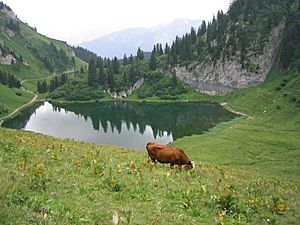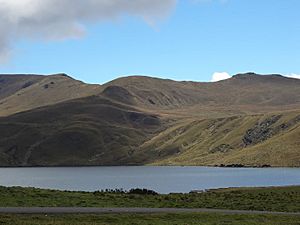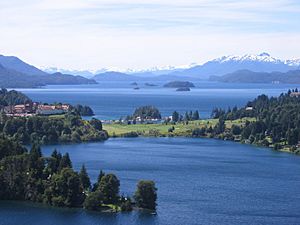Lake facts for kids


A lake is a large area of water that is completely surrounded by land. Think of it like a giant puddle, but much, much bigger and deeper than a pond! Because lakes are separated from the ocean, they are not considered a sea. However, some very large lakes were called "seas" in the past because of their huge size. Unlike rivers, lakes don't usually flow in one direction, but many have rivers that flow into them and out of them.
Most lakes on Earth contain fresh water, which means it's not salty. You'll find most of these freshwater lakes in the Northern Hemisphere. Did you know that over 60% of the world's lakes are in Canada? And Finland is famous for its many lakes, often called The Land of the Thousand Lakes, even though it has over 187,000!
Many lakes are actually made by people. These are called reservoirs. They are built for different reasons, like making electricity, for fun activities like boating, or to store water for irrigation (watering crops), industry, or for use in houses.
Sometimes, a lake doesn't have rivers flowing out of it, or the rivers are very small. In these cases, the lake mostly loses water when it evaporates into the air or soaks into the soil. In very dry places, where water evaporates quickly and the surrounding soil has a lot of salt, the lake water becomes very salty. These are called salt lakes. Famous salt lakes include the Great Salt Lake in the USA, the Caspian Sea, the Aral Sea, and the Dead Sea.
Contents
How are lakes formed?
Lakes aren't just magically there; they're formed in many different and exciting ways!
Glaciers: The Ice Carvers
Imagine a giant river of ice, called a glacier, slowly moving across the land. As it moves, it carves out huge valleys and hollows. When the glacier melts, these hollows fill with water, creating lakes. Many beautiful lakes in places like Canada, Alaska, and Scandinavia were formed this way. The Great Lakes in North America (Lake Superior, Lake Michigan, Lake Huron, Lake Erie, and Lake Ontario) are amazing examples! These lakes were formed over thousands of years by massive glaciers during the last ice age. Lake Superior, the largest of the Great Lakes, holds an incredible amount of water – it's truly massive!
Rivers: The Water Blockers
Sometimes, a river can get blocked. This can happen because of a landslide, a volcanic eruption, or even a beaver dam! When the water behind the blockage builds up, it forms a lake. These lakes can be small or very large, depending on the size of the river and the blockage.
Volcanoes: The Fiery Creators
Volcanoes can create lakes in a couple of ways. When a volcano erupts, it can leave behind a big bowl-shaped hole called a crater. If this crater fills with water, it forms a crater lake. These lakes are often very deep and have super clear water. Some volcanic lakes even have hot springs! Other lakes form when lava flows block a river valley, creating a lake behind the lava dam.
Earthquakes: The Shaky Makers
Earthquakes can cause the land to sink or crack. These sunken areas can then fill with water, forming lakes. You can find these types of lakes in many parts of the world where earthquakes happen often.
Oxbow Lakes: River Bends
Rivers often wind and bend, like a snake. Over time, a river might cut a new, straighter path. This leaves behind a curved section of the old river channel. This curved section fills with water, creating an Oxbow Lake. These lakes are often shaped like a crescent moon and are found in flat areas near rivers called floodplains.
Variety of Lakes
Lakes come in all shapes and sizes! Some are tiny, like little ponds, while others are enormous. The Caspian Sea is actually the world's largest inland body of water. It's so big, it's sometimes called a sea! It covers an area of about 143,244 square miles.
Lakes can also be different depths. Some are shallow, while others are incredibly deep. Lake Baikal in Siberia is the deepest lake in the world, reaching a depth of 5,387 feet! That's like stacking more than 10 Empire State Buildings on top of each other!
The water in lakes can also vary in color. Some lakes are crystal clear, while others are murky. Some can even be colored by minerals or tiny algae. The color can also change depending on the season and the weather.
Life in Lakes
Lakes are full of life! They are home to a wide variety of plants and animals. You can find fish, amphibians (like frogs), reptiles (like turtles), many different birds, and even mammals living in and around lakes. The types of plants and animals that live in a lake depend on things like the lake's size, depth, temperature, and how clean the water is. Many lakes support diverse ecosystems, providing homes for countless species. For example, Lake Victoria in Africa is home to over 200 species of fish, many of which are found nowhere else in the world.
Interesting facts about lakes
- The largest freshwater lake in the world by surface area is Lake Superior.
- The deepest lake in the world is Lake Baikal.
- The oldest lake in the world is Lake Baikal, which is thought to be around 25-30 million years old.
- Some lakes are salty, like the Great Salt Lake in Utah.
- Some lakes disappear and reappear depending on how much it rains.
Largest lakes by continent
- Africa - Lake Victoria, which is also the second largest freshwater lake on Earth. It is one of the Great Lakes of Africa.
- Antarctica - Lake Vostok. This lake is hidden under a thick sheet of ice!
- Asia - Lake Baikal is the largest lake completely in Asia. The Caspian Sea, the largest lake on Earth, is on the border between Europe and Asia, so both continents share it.
- Australia - Lake Eyre, which is usually dry. It only fills with water when there's a lot of rain.
- Europe - Lake Ladoga, followed by Lake Onega, both in northwestern Russia.
- North America - Lake Superior.
- South America - Lake Maracaibo is very large, but it's more like a bay because it has a wide opening to the sea. The largest freshwater lake in South America is Lake Titicaca. It's also the highest body of water on Earth where boats can travel, located at 3,821 meters (12,507 feet) above sea level!
Notable lakes
- The largest lake in the world by area is the Caspian Sea, covering 394,299 square kilometers. The largest freshwater lake by area is Lake Superior (82,414 square kilometers), which is part of the Great Lakes.
- The longest freshwater lake is Lake Tanganyika, with a length of about 660 kilometers. Lake Baikal is the second longest, at about 630 kilometers from end to end.
- The deepest lake is Lake Baikal in Siberia, with its bottom at 1,637 meters (5,371 feet) deep. Lake Tanganyika (1,470 meters) is the second deepest lake.
- The highest lake in the world is a small pond without a name on Ojos del Salado at 6,390 meters (20,965 feet). But the highest lake where boats can travel is Lake Titicaca in Peru and Bolivia at 3,812 meters (12,507 feet).
- The lowest lake in the world is the Dead Sea, located between Israel and Jordan. It's 418 meters (1,371 feet) below sea level! It's also one of the lakes with the highest salt concentration.
- Lake Enriquillo in the Dominican Republic is the only saltwater lake in the world where crocodiles live.
Related pages
Images for kids
-
Lake Sevan is the largest body of water in Armenia and the Caucasus region. It is one of the largest freshwater high-altitude (alpine) lakes in Eurasia.
-
Lake Tahoe on the border of California and Nevada
-
The shores of Lake Peipus, the fifth-largest lake in Europe, near the town of Kallaste in Estonia
-
The Seven Rila Lakes are a group of glacial lakes in the Bulgarian Rila mountains.
-
The crater lake of Mount Rinjani, Indonesia
-
Lake Kaniere is a glacial lake in the West Coast region of New Zealand.
-
The Nowitna River in Alaska. Two oxbow lakes – a short one at the bottom of the picture and a longer, more curved one at the middle-right.
-
These kettle lakes in Alaska were formed by a retreating glacier.
-
Ice melting on Lake Balaton in Hungary
-
Lake Mapourika, New Zealand
-
Five Flower Lake in Jiuzhaigou, Sichuan
-
Lake Teletskoye, Siberia
-
Lake of Flowers (Liqeni i Lulëve), one of the Lurë Mountains glacial lakes, Albania
-
Ephemeral 'Lake Badwater', a lake only noted after heavy winter and spring rainfall, Badwater Basin, Death Valley National Park, 9 February 2005. Landsat 5 satellite photo
-
Badwater Basin dry lake, 15 February 2007. Landsat 5 satellite photo
-
Titan's north polar hydrocarbon seas and lakes, as seen in a false-color Cassini synthetic aperture radar mosaic
-
The Caspian Sea is either the world's largest lake or a full-fledged sea
-
Round Tangle Lake, one of the Tangle Lakes, 2,864 feet (873 m) above sea level in interior Alaska
See also
 In Spanish: Lago para niños
In Spanish: Lago para niños

























